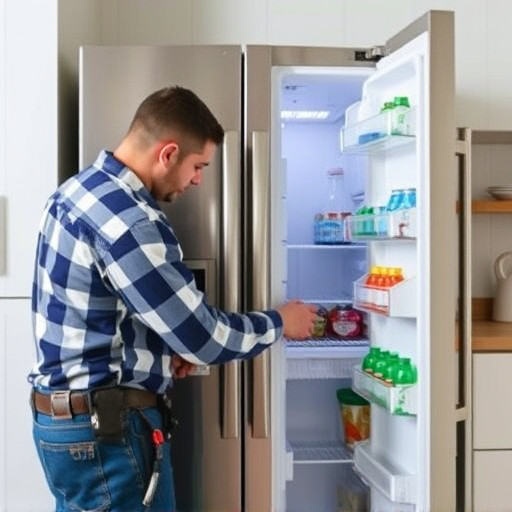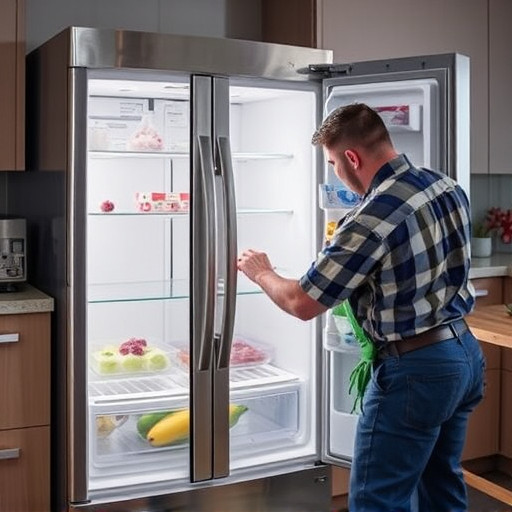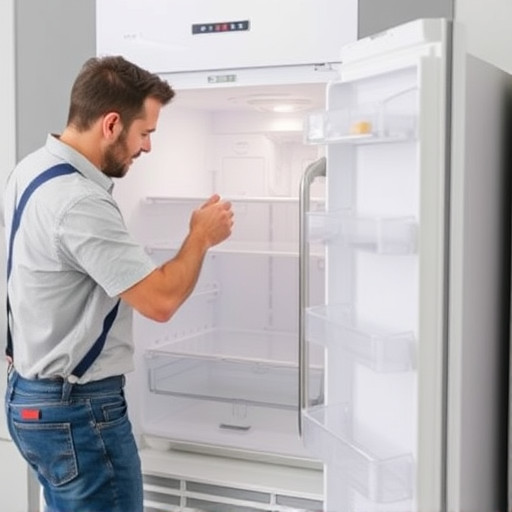Regular cleaning of evaporator and condenser coils in refrigerators is crucial for maintaining energy efficiency, preventing costly Refrigerator Repair, and ensuring optimal performance. Dust buildup on these coils reduces efficiency, increases energy consumption, and can lead to reduced cold storage capacity. To maintain optimal performance, locate the coils inside and outside the refrigerator, use a vacuum with a brush attachment to remove dust, and apply mild cleaning solutions for stubborn residue. Proper maintenance extends appliance lifespan and maximizes cooling capabilities.
Maintaining optimal performance in your refrigerator starts with understanding and keeping its critical components clean—the evaporator and condenser coils. These coils play a vital role in refrigeration, ensuring efficient temperature control. Regular cleaning is essential as buildup can lead to decreased cooling efficiency, higher energy consumption, and even costly refrigerator repair. This article guides you through the process, offering insights into why and how to effectively clean your coils for peak refrigerator performance, avoiding potential repair issues down the line.
- Understanding Evaporator and Condenser Coils: Their Role in Refrigeration
- Why Regular Cleaning is Essential for Optimal Performance
- Step-by-Step Guide to Efficient Coil Cleaning for Your Refrigerator Repair
Understanding Evaporator and Condenser Coils: Their Role in Refrigeration

Evaporator and condenser coils play a vital role in the refrigeration process, ensuring optimal performance in your refrigerator. These coils are essential components that facilitate heat transfer, driving the cooling mechanism within your appliance. The evaporator coil, situated within the fridge itself, absorbs heat from the interior, while the condenser coil, located outside, releases this absorbed heat into the environment. This dual-role system is what keeps your food fresh and at ideal temperatures.
Regular cleaning of these coils is crucial for maintaining efficient refrigeration. Over time, dust, dirt, and debris can accumulate, reducing their effectiveness. By keeping the evaporator and condenser coils clean, you ensure proper heat exchange, which translates to better energy efficiency and overall performance in your refrigerator repair.
Why Regular Cleaning is Essential for Optimal Performance

Regular cleaning of evaporator and condenser coils is a crucial aspect of maintaining optimal performance in refrigeration systems, such as those found in refrigerators. Over time, these coils can accumulate dust, dirt, and other debris, leading to reduced efficiency and even potential damage to the appliance. In the world of refrigerator repair, it’s important to understand that proper maintenance can prevent costly repairs and ensure your fridge runs smoothly for years to come.
When the coils become dirty, it restricts airflow and increases the workload on the compressor, resulting in higher energy consumption. A clean coil allows for efficient heat transfer, ensuring optimal cooling performance. Neglecting this routine cleaning can cause various issues, from increased electricity bills to reduced cold storage capacity. Therefore, taking the time to regularly wipe down and maintain these coils is essential for both the longevity of your refrigerator and your overall satisfaction with its cooling capabilities.
Step-by-Step Guide to Efficient Coil Cleaning for Your Refrigerator Repair

To ensure your refrigerator remains energy-efficient and performs optimally, regular evaporator and condenser coil cleaning is essential. Here’s a step-by-step guide to help with your refrigerator repair:
1. Power Off and Unplug: Before beginning any cleaning, switch off your refrigerator and unplug it from the power source for safety. Allow it to cool down completely.
2. Locate Coils: Identify the evaporator coils at the back or bottom of your refrigerator, and the condenser coils usually sit on the exterior. These coils are essential for cooling and require regular attention.
3. Clean with a Vacuum: Use a vacuum cleaner equipped with a brush attachment to gently remove dust, dirt, pet hair, and debris accumulated on both sets of coils. Pay close attention to hard-to-reach areas.
4. Apply Coiling Cleaning Solution: For more stubborn residue, mix a mild cleaning solution (like white vinegar or a dedicated coil cleaner) with water and apply it to the coils using a soft cloth or sponge. Never use abrasive materials that could damage the coils.
5. Rinse and Dry: Thoroughly rinse the area with clean water to remove any cleaning solution residue. Ensure all moisture evaporates completely before turning your refrigerator back on.
Maintaining optimal evaporator and condenser coil cleanliness is a crucial aspect of efficient refrigerator repair. By regularly cleaning these components, you ensure your fridge operates at peak performance, extending its lifespan and preserving food freshness. Implement the step-by-step guide provided to keep coils free from debris, dust, and grime, thereby enhancing energy efficiency and preventing costly repairs in the long run.
